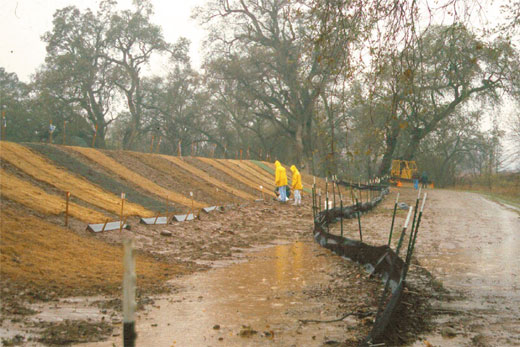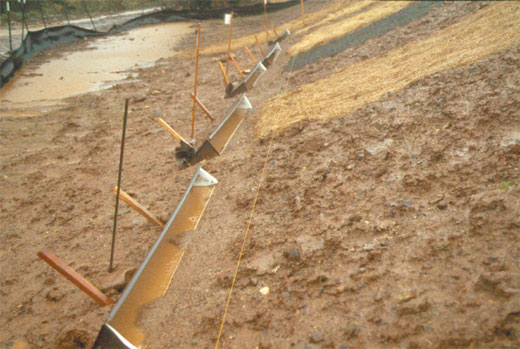
Most erosion and sedimentation occurred during the first winter storms. The treated slopes showed very little erosion.
Introduction
In the fall of 1998, Shasta Community College (Redding, California) implemented a comparative study of thirteen different erosion control blankets. Greenfix America, Calipatria, CA, and Reed & Graham, Inc., Sacramento, CA, provided erosion control blankets for the study. The blankets used were produced by many different manufacturers, including: Greenfix America, American Excelsior, Xcel, and North American Green. These blankets are referred to in the industry as Rolled Erosion Control Product (RECPs). RECPs are protective mulch blankets produced from organic fibers which are intended to temporarily stabilize and protect the soil surface from raindrop impact and surface erosion until plant cover can become established. There are many different materials from which the RECPs are constructed. For this study, Shasta College used RECPs made from straw, rice straw, straw/coconut, coconut, and aspen fibers (excelsior). The RECPs were compared with straw mulch and, of course, bare soil.
Instructors and students from various classes, including Watershed Restoration, Heavy Equipment Operation, Soils, Ecosystem Inventory, and Natural Resources Statistics, conducted the study from October 1998 through June 1999. One of the most notable results of the study was that on average, the blankets provided an 81% reduction in soil loss. Also noteworthy was the average soil loss of the equivalent of nearly 25 tons/acre on the bare soil plots, with no observed rills or gullies.
Site
A site on the Shasta Community College campus in Redding, California was chosen for the study. The study was conducted on the outer slope of the levee of a recently constructed water treatment detention pond. The study area was graded and “track walked” to ensure a uniform soil surface. Additionally, the slope was raked by hand to create a uniform seedbed. The slope was set to a gradient of 13/4:1, or approximately 60%. Slope length was approximately 16 feet. The slope was de-compacted to a depth of 6-8 inches. The soil type for the study area was classified as Churn Loam (CdA) and the textural class was a gravelly to sandy clay loam, and the erosion hazard was low to moderate (Soil Survey of Shasta County Area, 1974). This soil texture happens to be very representative of the urbanizing regions within the Redding area. The slope aspect was northeast.
| The purpose of the study was to test the effectiveness of RECPs to prevent erosion, aid in grass seed germination, and also to test the durability of the various blanket types, e.g. straw, straw/coconut, excelsior. |
Study
The purpose of the study was to test the effectiveness of RECPs to prevent erosion, aid in grass seed germination, and also to test the durability of the various blanket types, e.g. straw, straw/coconut, excelsior. However, the durability test was not conducted, as we were unable to obtain the proper instrumentation necessary to perform this part of the study. This paper will focus on the erosion (soil loss) portion of the study. A total of 15 study plots were created at the site. All plots were seeded with Elymus glaucus (blue wild rye), a local native grass, at a rate of 40#/acre. A total of 12 different blankets were installed in October 1998 by Shasta College faculty and students. The blankets were installed using the manufacturers instructions and under the supervision of a Certified Professional Erosion Control Specialist (CPECS). All blankets were installed at a length of 14 feet and width of 8 feet. The tops of the blankets were keyed-in at the top of the slope. One plot was mulched with straw mulch and two plots were left as controls (bare soil with seed only).
Before the first winter storm of 1998-99, sediment collection troughs were installed at the base of each study plot. The collection trough was a pre-manufactured 11” deep continuous (seemless) gutter, 6 feet long, with end caps and a downspout nipple attached. The 3” flange on the gutters was pounded into the slope to ensure the sediment-laden runoff went into the trough, not under. The gutters were installed with a 1-2% drop towards the downspout. A filter fabric screen was fastened to the outer end of the downspout to keep sediment from escaping.

Sediment is collecting in trough beneath one of the unprotected (unblanketed) plots. In the background, the blanketed plots have much less sediment in troughs. No rills or gullies are showing on unprotected plot. Nov. 1998.
Results
The troughs were emptied by hand a total of four times throughout the winter season. The City of Redding Grading Ordinance defines the winter season to be Oct. 15 - June 1, so that criteria was adopted for this study. Five gallon buckets were labeled and assigned to each plot for the collection and storage of sediment from each trough. At the end of the winter season, the depth of the sediment in each bucket was measured and a volume of sediment was calculated for each plot. The dry weight for a sample of soil with a known volume was determined. The dry weight for the sediment from each plot was calculated (in tons). The area of each plot was the same (112 sq. ft.) and was converted to acres. Soil loss was determined for each plot and is presented as tons/acre.
Average soil loss from the blanketed and straw mulched plots was 4.71 tons/acre, with a range from 3.09 to 7.36 tons/acre. The two unblanketed control plots showed an average soil loss of 24.83 tons/acre (23.04 and 26.61 tons/acre). It is important to note that no rills or gullies formed on the control plots. The use of RECPs and/or mulch resulted in an 81% reduction in soil loss compared to bare soil.
Conclusions
The results of this study indicate that without proper erosion control (blankets, mulching, etc.) on 60% slopes, approximately 25 tons/acre of soil (mostly fines) can be expected to be lost without the typical indicators of erosion (rills and gullies) even forming. This could be important information for the development/construction industry, as well as the public agencies that monitor and enforce the rules regulating discharge of stormwater off-site.
It can be reasonably assumed that if rills are visible, then the erosion rate will be much higher. Therefore, on unprotected construction site slopes composed of sandy or gravelly clay or loam soils, and even those with a low to moderate erosion hazard, the erosion and sediment rates will exceed 25 tons/acre. Conversely, the solutions are very simple. A protective covering of mulch will reduce the erosion and sedimentation by over 80%.
The Environmental Protection Agency (EPA) estimates that bare, unprotected soil from construction activities produce between 20-100 tons/acre. The Shasta College Study verifies the EPA estimates. The cumulative impacts to our national rivers and streams from these types of land disturbing activities are huge. The EPA is trying to address these non-point sources of pollution through the National Pollution Discharge Elimination System (NPDES) program, which is part of the Clean Water Act. A very clear statue of the NPDES regulations require that construction sites receive “surface stabilization practices” prior to the winter season.
This study hopefully adds critically needed quantitative data to the information already collected on the magnitude of erosion and sedimentation from construction activities. This study also provides and reaffirms that the most effective, and most necessary, Best Management Practice (BMP) for construction activities is surface stabilization, including mulching, hydraulic planting, RECPs or other types of surface cover. L&W
For more information, contact John McCullah, Salix Applied Earthcare, 491 South Street, Redding, CA 96001, (530)247-1600, fax (530)247-1601. Comparison charts relating to this project are available by contacting the author.
|
